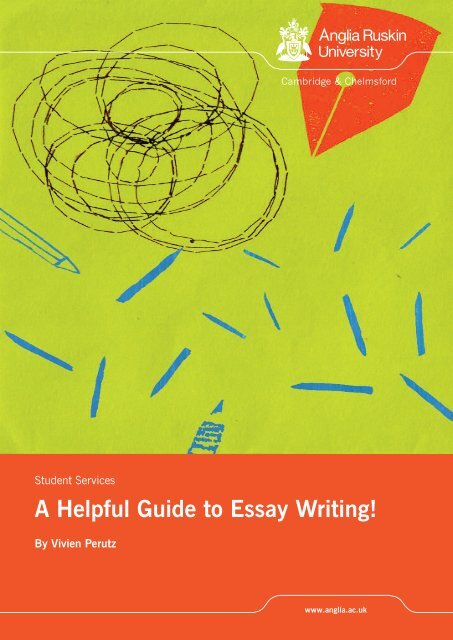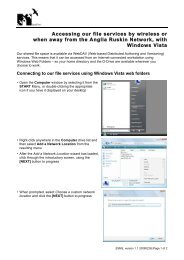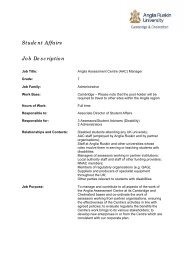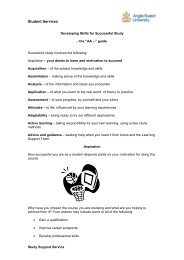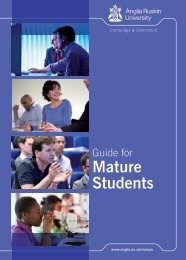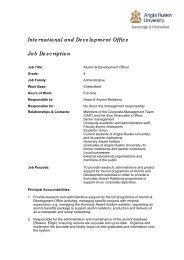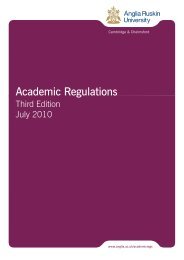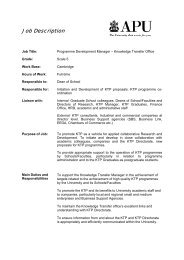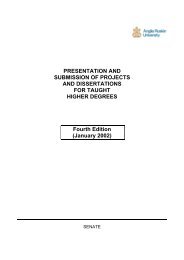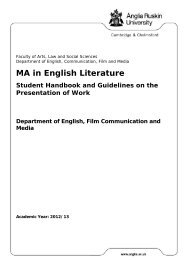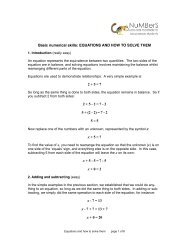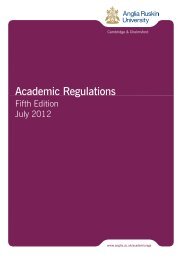A Helpful Guide to Essay Writing! - Anglia Ruskin University
A Helpful Guide to Essay Writing! - Anglia Ruskin University
A Helpful Guide to Essay Writing! - Anglia Ruskin University
You also want an ePaper? Increase the reach of your titles
YUMPU automatically turns print PDFs into web optimized ePapers that Google loves.
Student Services<br />
A <strong>Helpful</strong> <strong>Guide</strong> <strong>to</strong> <strong>Essay</strong> <strong>Writing</strong>!<br />
By Vivien Perutz
ESSAY WRITING<br />
Contents<br />
Page<br />
Introduction 3<br />
Part 1 – structure and organisation 4<br />
A good essay structure 4<br />
A model essay structure 4<br />
<strong>Essay</strong> writing – the main stages 5<br />
Stage 1 – analysing the question 6<br />
Key words in essay titles 6<br />
Stage 2 – planning 8<br />
Stage 3 – use your plan <strong>to</strong> guide your research 9<br />
Stage 4 – refine your plan 9<br />
Stage 5 – drafting 10<br />
Stage 6 – editing your draft 10<br />
Useful linking words and phrases 11<br />
Part 2 – style and clarity 14<br />
Academic writing style 14<br />
Descriptive writing 14<br />
Argumentative writing 15<br />
Evaluative writing 15<br />
Using personal experience 16<br />
A critical, analytical approach 17<br />
Using your reading <strong>to</strong> support your writing 18<br />
Citing references in text – some useful expressions 19<br />
Conventions of style in academic writing 20<br />
Expressing your ideas clearly 21<br />
Spot the gaffe! 22<br />
Sources of further guidance 23<br />
Useful websites 23<br />
2
Introduction<br />
Please note the following is general guidance; different courses<br />
have different demands. You should check with individual tu<strong>to</strong>rs<br />
regarding specific requirements.<br />
The guide is partly based on material gathered and adapted from a<br />
range of publications listed in the further reading section at the end.<br />
Part 1 concentrates on structural and organisational aspects. Part 2<br />
offers guidance on style and clarity in essay writing.<br />
The guidelines should be taken as just that. There is no rule, for<br />
example, that says you must plan an essay before writing it. Some<br />
people find that they work best by getting the ideas flowing first and<br />
imposing some sort of structure later; it is only once they start writing<br />
that they start <strong>to</strong> have an idea of what their direction will be. Even so,<br />
they must be clear at the outset as <strong>to</strong> what the essay title requires of<br />
them <strong>to</strong> make sure that they stay within its constraints. If, however, you<br />
are fairly new <strong>to</strong> essay writing and not very confident about it, you might<br />
find it helpful <strong>to</strong> follow the suggested stages on pages 6 – 13.<br />
3
PART 1 – STRUCTURE AND ORGANISATION<br />
A good essay structure<br />
• Is made easier by prior planning.<br />
• Makes it clear how you are going <strong>to</strong> address the question, where you<br />
are going and why.<br />
• Sets out your main ideas clearly.<br />
• Makes it clear how the main ideas relate <strong>to</strong> each other.<br />
• Takes the reader through your answer in a logical, progressive way.<br />
• Helps the reader <strong>to</strong> remember what you have said.<br />
• Organises groups of related information in paragraphs.<br />
• Uses connecting words and phrases <strong>to</strong> relate each point/idea <strong>to</strong><br />
earlier and later points (see page 12).<br />
A model essay structure<br />
Introduction<br />
• Arouse the reader’s interest<br />
• Set the scene<br />
• Explain how you interpret the question set<br />
• Define or explain key terms if necessary<br />
• Give a brief outline of which issues you will explore, and in which<br />
order<br />
Argument/Main Body<br />
Contains the points outlined in your introduction, divided in<strong>to</strong><br />
paragraphs:<br />
• Paragraph 1<br />
Covers the first thing you said you would address.<br />
The first sentence (the <strong>to</strong>pic sentence) introduces the main idea of<br />
the paragraph.<br />
4
Other sentences develop the <strong>to</strong>pic.<br />
Include relevant examples, details, evidence, quotations, references.<br />
• Paragraph 2 and other paragraphs<br />
The first sentence links the paragraph <strong>to</strong> the previous paragraph<br />
then introduces the main idea of the paragraph.<br />
The Conclusion<br />
• Draw everything <strong>to</strong>gether<br />
• Summarise the main themes<br />
• State your general conclusions<br />
• Make it clear why those conclusions are important or significant<br />
• Do not introduce new material<br />
• In the last sentence, sum up your argument very briefly, linking it <strong>to</strong><br />
the title<br />
• Set the issues in a broader perspective/wider context<br />
• Discuss what you have failed <strong>to</strong> do – answers not clear, space<br />
limited<br />
• Suggest further questions of your own<br />
<strong>Essay</strong> writing – the main stages<br />
1. Analyse the question<br />
2. Make a rough outline plan<br />
3. Use plan <strong>to</strong> guide research<br />
4. Review, revise and refine the plan<br />
5. Write first draft<br />
6. Edit draft for structure and content<br />
7. Edit draft for style<br />
8. Check referencing<br />
9. Proof read for spelling/punctuation<br />
10. Produce final copy<br />
5
Stage 1 - Analysing the essay question<br />
• Read the question (aloud if it helps!) several times.<br />
• Underline the words that tell you what approach <strong>to</strong> take<br />
discuss, assess, compare – see key words below).<br />
(e.g.<br />
• Highlight key words relating <strong>to</strong> the subject matter.<br />
• Circle any other significant words that identify the scope of what you<br />
have <strong>to</strong> write about (e.g. simply, fundamentally, only, merely,<br />
currently, respectively).<br />
• Note any terms that you need <strong>to</strong> define.<br />
• Write the question out in your own words.<br />
• In your introduction say how you interpret the question (e.g. by<br />
rephrasing in your own words)<br />
• In your conclusion, refer back <strong>to</strong> the question; show the reader that<br />
you are still answering the set question.<br />
• Write the question out in full on plans, notes and drafts <strong>to</strong> make sure<br />
you do not lose sight of it.<br />
Key words in essay titles<br />
NB. You might find that the title you have been given does not contain<br />
any of these key words. You will have <strong>to</strong> look carefully at the way the<br />
question is phrased, along with any accompanying guidance as <strong>to</strong> what<br />
is expected (e.g. learning outcomes in module guide) <strong>to</strong> establish what<br />
sort of approach is required.<br />
Account for<br />
Give reasons for; explain why something happens.<br />
Analyse<br />
Break up in<strong>to</strong> parts; investigate.<br />
Comment on<br />
Identify and write about the main issues; give your reactions based on<br />
what you have read/heard in lectures. Avoid just personal opinion.<br />
6
Compare<br />
Look for the similarities/differences between two things. Show the<br />
relevance or consequences of these similarities. Perhaps conclude<br />
which is preferable.<br />
Contrast<br />
Bring out the differences between two items or arguments. Show<br />
whether the differences are significant. Perhaps give reasons why one<br />
is preferable.<br />
Critically evaluate<br />
Weigh arguments for and against something, assessing the strength of<br />
the evidence on both sides. Use criteria <strong>to</strong> guide your assessment of<br />
which opinions, theories, models or items are preferable.<br />
Define<br />
Give the exact meaning of. Where relevant, show you understand how<br />
the definition may be problematic.<br />
Describe<br />
Give the main characteristics or features of something, or outline the<br />
main events.<br />
Discuss<br />
Investigate or examine by argument; sift and debate; give reasons for<br />
and against; examine the implications.<br />
Distinguish between<br />
Bring out the differences between.<br />
Evaluate<br />
Assess and give your judgement about the merit, importance or<br />
usefulness of something. Back your judgement with evidence.<br />
Examine<br />
Look closely in<strong>to</strong> something.<br />
Explain<br />
Make clear why something happens, or is the way it is; interpret and<br />
account for; give reasons for.<br />
Explore<br />
Examine thoroughly; consider from a variety of viewpoints.<br />
Illustrate<br />
Make something clear and explicit, giving examples of evidence.<br />
7
Interpret<br />
Show the meaning and relevance of data or other material presented<br />
Justify<br />
Give evidence which supports an argument or idea; show why a<br />
decision or conclusions were made; answer the main objections which<br />
might be made.<br />
Narrate<br />
Outline what happened.<br />
Outline<br />
Give the main points/features/general principles; show the main<br />
structure and interrelations; omit details and examples.<br />
Relate<br />
(a) Narrate<br />
(b) Show similarities and connections between<br />
State<br />
Give the main features briefly and clearly.<br />
Summarise<br />
Draw out the main points only; omit details and examples.<br />
To what extent<br />
Consider how far something is true, or contributes <strong>to</strong> a final outcome.<br />
Consider also ways in which it is not true.<br />
Trace<br />
Follow the development or his<strong>to</strong>ry of an event or process.<br />
Stage 2 – Planning<br />
Make an outline plan<br />
• Keep the question in sight<br />
• Try using a “spider” or “pattern plan” <strong>to</strong> brains<strong>to</strong>rm relevant points –<br />
both what you know and what you need <strong>to</strong> find out. This type of plan<br />
reflects the way your brain works and helps <strong>to</strong> give you an overview<br />
of the essay<br />
(See <strong>Anglia</strong> <strong>Ruskin</strong>’s on-line guide on mind mapping at<br />
http://www.anglia.ac.uk/ruskin/en/home/central/studentsupport/servic<br />
es/learning/on_line_study_skills.html)<br />
8
Give star ratings <strong>to</strong> the points you have noted:<br />
*** for key points<br />
** for important points<br />
* for background points<br />
Use different colours, letters or lines <strong>to</strong> show links<br />
Number the key points in the order you think you will introduce them.<br />
• Try out “Mind Genius”, a mind mapping programme on the open<br />
access computers in the <strong>University</strong> Library.<br />
• Try ways of planning where you can physically arrange the points:<br />
Different points on separate index cards – colour code<br />
“Post-its” on a sheet of wallpaper.<br />
Stage 3 – Use your plan <strong>to</strong> guide your research<br />
• Armed with your outline plan, use skimming and scanning strategies<br />
<strong>to</strong> identify material relevant <strong>to</strong> your key points (see on-line guide on<br />
reading for academic purposes)<br />
• Use an active, critical, questioning approach <strong>to</strong> read the material you<br />
have identified (see <strong>Anglia</strong> <strong>Ruskin</strong>’s on-line guides at<br />
http://www.anglia.ac.uk/ruskin/en/home/central/studentsupport/<br />
services/learning/on_line_study_skills.html)<br />
Stage 4 - Refine your plan<br />
• If your research has drawn out key points you would have missed<br />
out, include them. Delete anything that now seems irrelevant or<br />
unimportant.<br />
• Work out the order for introducing key points.<br />
• Convert your outline plan in<strong>to</strong> a linear plan – list the main<br />
<strong>to</strong>pics/arguments as headings in order.<br />
• Code (colour, letters, numbers) the headings.<br />
• For each main <strong>to</strong>pic/argument note the main information you will<br />
include and the examples/other supporting details.<br />
9
• Divide up your word allowance between the headings – allow one<br />
tenth each for the introduction and conclusion.<br />
• Work out how many words per page you write in your handwriting.<br />
Select the <strong>to</strong>tal number of pages you will need. Draw out pages<br />
showing what <strong>to</strong>pics you’ll include on each page.<br />
• Sort your research notes – use the code colour, number or letter <strong>to</strong><br />
relate them <strong>to</strong> your plan.<br />
• Start drafting!<br />
Stage 5 - Drafting<br />
• If you have a mental block with the introduction, start with the<br />
“middle”, with a <strong>to</strong>pic/idea you feel most comfortable with.<br />
• Take each main <strong>to</strong>pic/idea and write a paragraph about it.<br />
• Do not worry about style/spelling at this stage – let the ideas flow.<br />
• For each paragraph include a “<strong>to</strong>pic sentence” that makes it clear<br />
what that paragraph is about. The rest of the paragraph will include<br />
information and evidence related <strong>to</strong> that “<strong>to</strong>pic”.<br />
• Leave space for editing.<br />
• Write the conclusion – it should sum up the content of the “middle”<br />
and relate back <strong>to</strong> the title.<br />
• Write the introduction – it is easier <strong>to</strong> say what your essay sets out <strong>to</strong><br />
do once you have done it.<br />
• If you have word-processed your draft, print off a hard copy for<br />
editing purposes.<br />
• Put the draft aside for a day or so – come back <strong>to</strong> it with a fresh pair<br />
of eyes.<br />
Stage 6 – Editing your draft<br />
First re-read your draft, checking for structure and content:<br />
• Does the main body do what the introduction says it will do?<br />
10
• Is it clear what each paragraph is about? (Highlight the <strong>to</strong>pic<br />
sentence; sum up the <strong>to</strong>pic in the margin and colour code it.)<br />
• Is every paragraph relevant <strong>to</strong> the question?<br />
• Is everything in the paragraph relevant <strong>to</strong> the main “<strong>to</strong>pic”?<br />
• Is there enough in each paragraph <strong>to</strong> support the “<strong>to</strong>pic”?<br />
• Is anything repeated/superfluous?<br />
• Is everything in the right place?<br />
• Are the sentences in each paragraph in the right order?<br />
• Does every paragraph relate clearly <strong>to</strong> the others? (See useful<br />
linking words and phrases).<br />
Check again for style and presentation:<br />
• Are the ideas clearly expressed, in an academic style?<br />
• Have you cited references correctly and listed them at the end?<br />
• Does the spelling/punctuation help the reader?<br />
Useful linking words and phrases<br />
To indicate a contrast:<br />
however on the other hand in contrast<br />
alternatively on the contrary conversely<br />
in comparison rather in fact<br />
another possibility better/worse still but<br />
despite this notwithstanding in spite of<br />
nevertheless for all that yet<br />
all the same instead although<br />
11
To provide an illustration:<br />
for example as follows that is<br />
that is <strong>to</strong> say for instance say<br />
in other words namely such as<br />
chiefly mainly most importantly<br />
typical of this/such notably one such<br />
including especially not least<br />
a typical/particular/<br />
key example<br />
in particular<br />
To extend a point:<br />
similarly equally indeed in addition<br />
in the same way in addition likewise<br />
<strong>to</strong>o besides also<br />
above all as well furthermore<br />
To show cause and effect/conclusion:<br />
so therefore accordingly<br />
thus hence then<br />
it follows that for this reason this implies<br />
in this/that case consequently because of this/that<br />
this suggests that in conclusion in short<br />
<strong>to</strong> conclude In brief in all<br />
it might be concluded<br />
from this<br />
as a result/<br />
consequence<br />
accepting/assuming<br />
this<br />
owing <strong>to</strong>/due <strong>to</strong> the<br />
fact that<br />
12<br />
resulting from/<br />
in consequence of this<br />
accepting/assuming<br />
this
To show the next step:<br />
first(ly) second(ly) <strong>to</strong> begin/start with<br />
lastly last but not least ultimately<br />
first and foremost finally another<br />
then after next<br />
afterwards third(ly) first and most<br />
importantly<br />
in the first/second<br />
place<br />
13
Academic writing style<br />
PART 2 – STYLE AND CLARITY<br />
Stella Cottrell (2003) refers <strong>to</strong> three main styles used in academic<br />
writing: descriptive, argumentative and evaluative. Many writing tasks<br />
will involve some combination of the three and the use of critical,<br />
analytical skills. Some courses will require a degree of more personal,<br />
reflective writing. Some guidelines are provided here, but see the<br />
separate on-line guide on reflective writing for further guidance if this<br />
type of writing is required on your course.<br />
Descriptive writing<br />
Different purposes:<br />
• To describe what happened: e.g. main events. methods, findings.<br />
• To describe the main features or functions: e.g. of a policy, practice,<br />
method.<br />
• To summarise the main points: e.g. of a theory or article.<br />
<strong>Guide</strong>lines:<br />
• Identify relevant themes <strong>to</strong> include<br />
• Be clear, precise and accurate<br />
• Use a logical order<br />
• Keep <strong>to</strong> the point<br />
• Indicate the significance of what you describe<br />
NB. Descriptive style varies between subjects – get used <strong>to</strong> what your<br />
subject expects.<br />
14
Argumentative <strong>Writing</strong><br />
Purpose:<br />
To argue a case/point of view, <strong>to</strong> influence the reader’s thoughts/actions<br />
<strong>Guide</strong>lines:<br />
• State your position clearly and concisely.<br />
• Use a clear line of reasoning <strong>to</strong> support your position.<br />
• Give reliable, relevant, valid and convincing evidence/examples <strong>to</strong><br />
support your reasons.<br />
• Consider and respond <strong>to</strong> the possible arguments against.<br />
• Try not <strong>to</strong> sit on the fence – show there are different arguments but<br />
make clear which you find most convincing.<br />
Evaluative <strong>Writing</strong><br />
Involves:<br />
• Comparing - finding points of similarity.<br />
• Contrasting – finding points of difference.<br />
• Evaluating significance of similarities and differences. Do they<br />
matter? Do they have important implications for which model should<br />
be used? How did you decide what was significant?<br />
• Making a judgement. Give reasons for your opinion, based on the<br />
evidence.<br />
15
• Showing your criteria. Show what criteria you used <strong>to</strong> arrive at your<br />
opinion – e.g. data, research evidence<br />
• Get the balance right – compare like with like and give equal<br />
information and evidence <strong>to</strong> both.<br />
Using Personal Experience<br />
• Only use if your course requires it.<br />
• Do not use as your main evidence unless you’re specifically asked <strong>to</strong><br />
do so.<br />
• Points <strong>to</strong> consider when including personal experience:<br />
- How typical is your experience?<br />
(Any research done? Any relevant reports or articles?)<br />
- How does your experience compare with other people’s?<br />
- How relevant is it?<br />
- How does it link <strong>to</strong> theories you have studied?<br />
- How does it support or contradict theories and views you have<br />
studied?<br />
- Can any lessons be drawn from it?<br />
- Can any valid generalisations be drawn from it?<br />
• Personal writing uses different language:<br />
“I found that” rather than “It was found that”<br />
(More emotional, subjective, intuitive and anecdotal)<br />
16
A critical, analytical approach<br />
As students move beyond Level 1 work <strong>to</strong> Levels 2 and 3, tu<strong>to</strong>rs often<br />
comment that the work is <strong>to</strong>o descriptive and needs <strong>to</strong> be more<br />
analytical and/or critical.<br />
Being analytical is about breaking things (situations, practices,<br />
problems, statements, ideas, theories, arguments) down in<strong>to</strong> their<br />
component parts.<br />
Being critical is about not accepting things at face value, but evaluating<br />
them i.e. making reasoned judgements about how valid, effective,<br />
important, relevant, useful and worthwhile they are.<br />
The argumentative and evaluative writing styles referred <strong>to</strong> above<br />
reflect this analytical, critical approach.<br />
To demonstrate the analytical/critical thinking expected means asking<br />
lots of questions of everything you read, observe, hear, experience<br />
and do <strong>to</strong> probe beneath the surface, looking for reasons, explanations<br />
and motives.<br />
See Cottrell (2003) for guidance and activities <strong>to</strong> help develop critical<br />
thinking skills.<br />
See also <strong>Anglia</strong> <strong>Ruskin</strong>’s on-line guides “Critical analytical thinking” and<br />
“Evaluating an argument” found at:<br />
http://www.anglia.ac.uk/ruskin/en/home/central/studentsupport/services/<br />
learning/on_line_study_skills.html<br />
Use of the linking words and phrases on page 11 and the expressions<br />
for citing references on page 19 will help <strong>to</strong> show that you have used an<br />
analytical, critical approach.<br />
17
Using your reading <strong>to</strong> support your writing<br />
In developing your ideas and arguments in an essay you need <strong>to</strong> refer<br />
<strong>to</strong> a range of books, journals and other material <strong>to</strong> support your<br />
views/statements and give weight <strong>to</strong> your arguments. However<br />
Do not<br />
Do<br />
Do not<br />
Do<br />
Do not<br />
Do<br />
Do not<br />
Do<br />
Do not<br />
Do<br />
Do not<br />
Do<br />
pass off other people’s ideas as your own (plagiarism!).<br />
acknowledge your sources of ideas and information<br />
(see the library’s on-line guide on Harvard Referencing<br />
under “Library <strong>Guide</strong>s” at:<br />
http://libweb.anglia.ac.uk/referencing/harvard.htm).<br />
just piece <strong>to</strong>gether other people’s ideas <strong>to</strong> construct your<br />
own argument.<br />
use other people’s ideas <strong>to</strong> scaffold your own argument.<br />
“decorate” your essay with lots of direct quotes <strong>to</strong> prove<br />
you have read lots of books.<br />
use direct quotes sparingly, introduce them carefully and<br />
make it clear how they relate <strong>to</strong> your ideas.<br />
present other people’s ideas as fact.<br />
show you’ve critically questioned other people’s work <strong>to</strong><br />
inform your own learning.<br />
just cite authors who agree with you.<br />
bring in opposing ideas and show why you think they are<br />
mistaken.<br />
read passively, just collecting ideas and reading the lines.<br />
engage with your reading – link it <strong>to</strong> other things you have<br />
learned/read, ask questions, use it <strong>to</strong> develop your opinions<br />
and attitudes – read between the lines.<br />
18
The following expressions will be useful for introducing other people’s<br />
ideas in your essays.<br />
Citing References in Text – some useful expressions<br />
Introducing someone’s ideas:<br />
Bloggs (2002)<br />
suggests/argues/states/believes/concludes/proposes that ---<br />
expresses/holds the view that ---<br />
draws attention <strong>to</strong> ---<br />
describes X as ---<br />
describes how ---<br />
refers <strong>to</strong> ---<br />
takes the stance that ---<br />
emphasises/stresses the need <strong>to</strong>/the importance of---<br />
According <strong>to</strong> Bloggs (2002) ---<br />
As stated/suggested/argued/proposed by Bloggs (2002) ---<br />
There is a view/theory/argument that --- (Bloggs, 2002).<br />
It has been suggested/stated/argued/proposed that --- (Bloggs, 2002)<br />
One view/theory/argument/suggestion/proposal is that --- (Bloggs,<br />
2002)<br />
One view, expressed by Bloggs (2002) is that ---<br />
Introducing an idea/theory that agrees with/has built on another:<br />
This is supported by Smith (2003).<br />
in line with the view/theory/suggestion of Smith (2003).<br />
reflects the “ “ “<br />
Smith (2003) accepts/supports/agrees with/concurs with this<br />
view/suggestion/theory.<br />
A similar view is held by Smith (2003)<br />
” ” stance is taken by<br />
This idea/theory has been extended/developed/taken further/built upon<br />
by Smith (2003).<br />
19
Introducing an idea/theory that disagrees/contrasts with another:<br />
This conflicts/contrasts with/is contrary <strong>to</strong> the view held by Smith (2003)<br />
that ---<br />
This is not accepted by/has been challenged by Smith (2003), who<br />
argues that ---<br />
Smith (2003), on the other hand/however/in contrast, suggests that ---<br />
An alternative view/suggestion is that --- (Smith, 2003)<br />
The opposite/a conflicting view is expressed by Smith (2003)<br />
Conventions of style in essays<br />
• Use formal, standard English - avoid colloquial terms and dialect.<br />
(“You write as you speak” is a common complaint from tu<strong>to</strong>rs!”).<br />
• Avoid abbreviations and contractions<br />
(use “for example”, not “e.g.”; use “did not” instead of “didn’t”).<br />
Proper Nouns (e.g. the National Health Service) can be abbreviated<br />
provided you give the full name as well as the abbreviation on the<br />
first use.<br />
• Numbers below ten are written out in full, except in statistical and<br />
scientific work.<br />
• Be impersonal (unless your course requires otherwise) – avoid using<br />
“I”, “we” and “you”. Instead use “It can be seen that”, “There are a<br />
number of”, “It has been found that” etc.<br />
• Be cautious. Avoid sweeping statements - use words and phrases<br />
such as “appears <strong>to</strong>, “seems <strong>to</strong>”, “may”, “probably”, “apparently”,<br />
“generally”, “The evidence suggests that”, “In some cases this”.<br />
• Use rational argument rather than emotive language.<br />
• Be objective – avoid personal, subjective words such as “wonderful”,<br />
“worthwhile”.<br />
• Use continuous prose – lists and headings are for reports and<br />
projects.<br />
• Do not address the reader directly by asking them a direct question<br />
or telling them what <strong>to</strong> think.<br />
20
Expressing your ideas clearly<br />
• Be clear in your own mind what you want <strong>to</strong> say.<br />
• Express ideas clearly – the reader can not ask questions <strong>to</strong> clarify.<br />
• Be concise - make every word and sentence count; avoid repetition,<br />
fillers and unnecessary words.<br />
(e.g. an annual income of £20,000 per annum)<br />
• Be precise – avoid generalisations and vagueness.<br />
(Specify who, what, where, when and how)<br />
• Use short, straightforward sentences. (See “Reader loses way in<br />
long-winded sentence”).<br />
• Use plain English and familiar words.<br />
(e.g. Death – not “negative patient care outcome”).<br />
• Avoid clichés (e.g. at the end of the day, the bot<strong>to</strong>m line is).<br />
• Use the correct words – beware of commonly misused words.<br />
(e.g. affect/effect, principle/principal, adverse/averse).<br />
• Avoid ambiguous words and sentences.<br />
(e.g. Water is available below the ground surface and most of the<br />
country’s crops are grown there).<br />
• Check your punctuation – it should help, not confuse, the reader.<br />
(See <strong>Anglia</strong> <strong>Ruskin</strong>’s on-line guide on punctuation).<br />
• Check your spelling. Make a point of learning <strong>to</strong> spell words used<br />
commonly in your subject and in academic writing generally.<br />
(See <strong>Anglia</strong> <strong>Ruskin</strong>’s on-line guide on spelling).<br />
Reader loses way in long-winded sentence!<br />
The respondents, however, in spite of their doubts about the single<br />
currency, foresaw many benefits, including the elimination of the risks<br />
involved with currency exchange, the equalization of currencies, the<br />
reduced administrative costs (e.g. in billing) and the psychological<br />
benefits attached because of a strengthening of the bonds between<br />
countries and it being evidence of a united European economic power.<br />
21
Break the sentence up in<strong>to</strong> its different parts:<br />
The correspondents had doubts about the single currency but they<br />
foresaw many benefits. The risks taken in exchanging currencies would<br />
be removed, currencies would be equalized and administrative costs<br />
would be reduced. Moreover, psychologically, bonds between countries<br />
would be strengthened by the existence of a united European economic<br />
power.<br />
Spot the gaffe!<br />
Based on the guidance, see if you can identify the problems with the<br />
following examples:<br />
At this moment in time it goes without saying that the situation is not<br />
satisfac<strong>to</strong>ry in any shape or form. The long and short of it is that it is<br />
believed that we must leave no s<strong>to</strong>ne unturned <strong>to</strong> rectify the situation at<br />
grass roots level.<br />
Coming round from the operation, I noticed he was a funny sort of<br />
colour.<br />
Everybody knows that ours is an undervalued profession, which effects<br />
staff moral.<br />
A well-conceived organisation constitutes a fundamental component of<br />
efficacious management.<br />
We have <strong>to</strong> remember that the Governments’ main aim is <strong>to</strong> save<br />
money so it’s latest plans’ are just another attempt <strong>to</strong> provide education<br />
on a shoe string budget.<br />
When you’re an engineer you’ve got <strong>to</strong> write loads of reports so it’s<br />
worth brushing up your writing skills.<br />
Gemma had not sought any contraceptive advice prior <strong>to</strong> this occasion,<br />
even though she could of attended her local family planning clinic,<br />
probably because of a number of fac<strong>to</strong>rs, one of which could be the<br />
name, which might prevent young people attending when their not<br />
planning <strong>to</strong> have a family, as suggested by Brown and Bloggs (1995).<br />
22
Referencing<br />
When writing an essay, report or other assignment you will often need<br />
<strong>to</strong> support your arguments by referring <strong>to</strong> other published work such as<br />
books, journal or newspaper articles, government reports, dissertations<br />
and theses, and material from the Internet.<br />
You will need <strong>to</strong> give accurate references:<br />
• To give credit <strong>to</strong> other authors' concepts and ideas<br />
• To provide the reader (often the marker/examiner of the<br />
assignment) with evidence of the breadth and depth of your<br />
reading<br />
• To enable the readers of your work <strong>to</strong> locate the references easily<br />
• To avoid being accused of plagiarism, an academic offence which<br />
can lead <strong>to</strong> loss of marks or module failure<br />
For detailed information on how <strong>to</strong> reference please visit the <strong>University</strong><br />
Library’s website: http://libweb.anglia.ac.uk/referencing/referencing.htm<br />
Sources of further guidance<br />
Cottrell, S. 2003 Critical thinking skills: developing effective analysis and<br />
argument. Basings<strong>to</strong>ke: Palgrave Macmillan<br />
Cottrell, S. 2003 The study skills handbook, 2 nd ed., Basings<strong>to</strong>ke:<br />
Palgrave Macmillan<br />
Crème. P. and Lea, M.R., <strong>Writing</strong> at <strong>University</strong>, 2 nd ed., Maidenhead:<br />
Open <strong>University</strong> Press<br />
Fairbairn, G.J. and Winch, C., Reading, <strong>Writing</strong> and Reasoning,<br />
Buckingham, Open <strong>University</strong> Press<br />
Greetham, B. How <strong>to</strong> write better essays, Basings<strong>to</strong>ke: Palgrave<br />
Rose, J. The mature student’s guide <strong>to</strong> writing , Basings<strong>to</strong>ke: Palgrave<br />
Useful websites<br />
Student Services website<br />
http://www.anglia.ac.uk/ruskin/en/home/central/studentsupport/services/<br />
learning/on_line_study_skills.html<br />
Library website<br />
http://libweb.anglia.ac.uk/referencing/harvard.htm<br />
23
Reviewed July 2008<br />
Reprinted July 2010<br />
Published by Student Services<br />
student.services@anglia.ac.uk<br />
www.anglia.ac.uk/studentservices<br />
Cover image by Nikki Gardham<br />
(<strong>Anglia</strong> <strong>Ruskin</strong> <strong>University</strong> BA (Hons)<br />
Illustration student)


